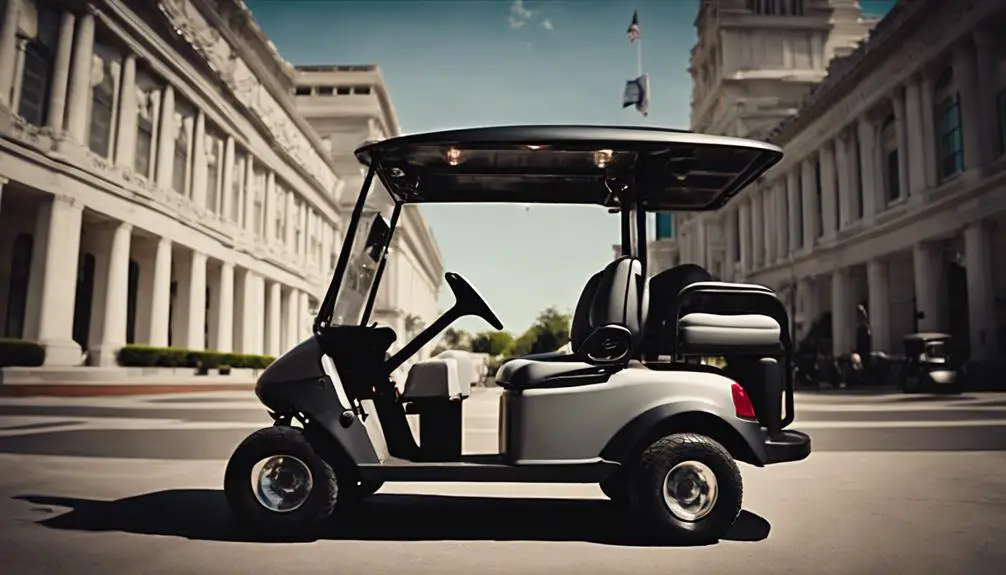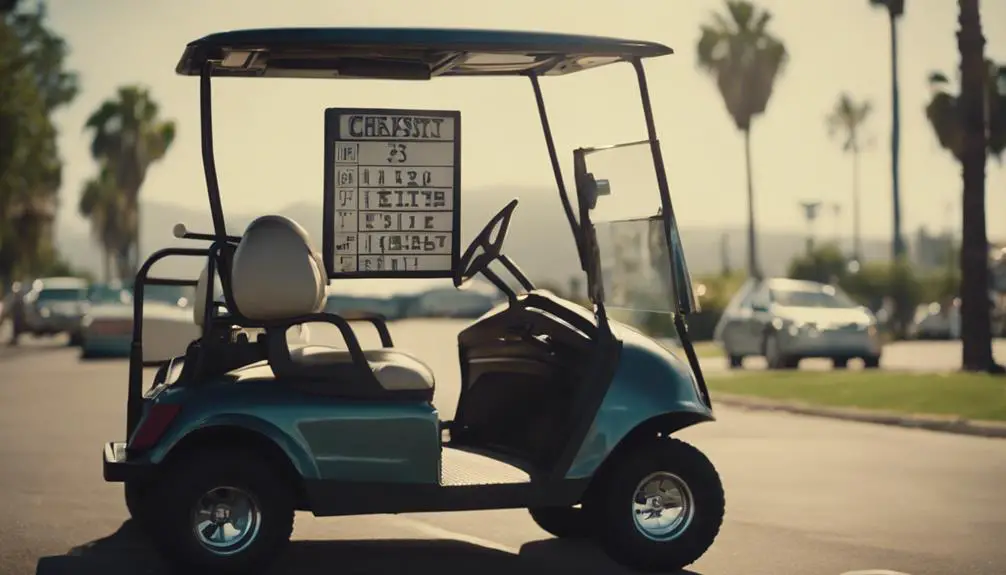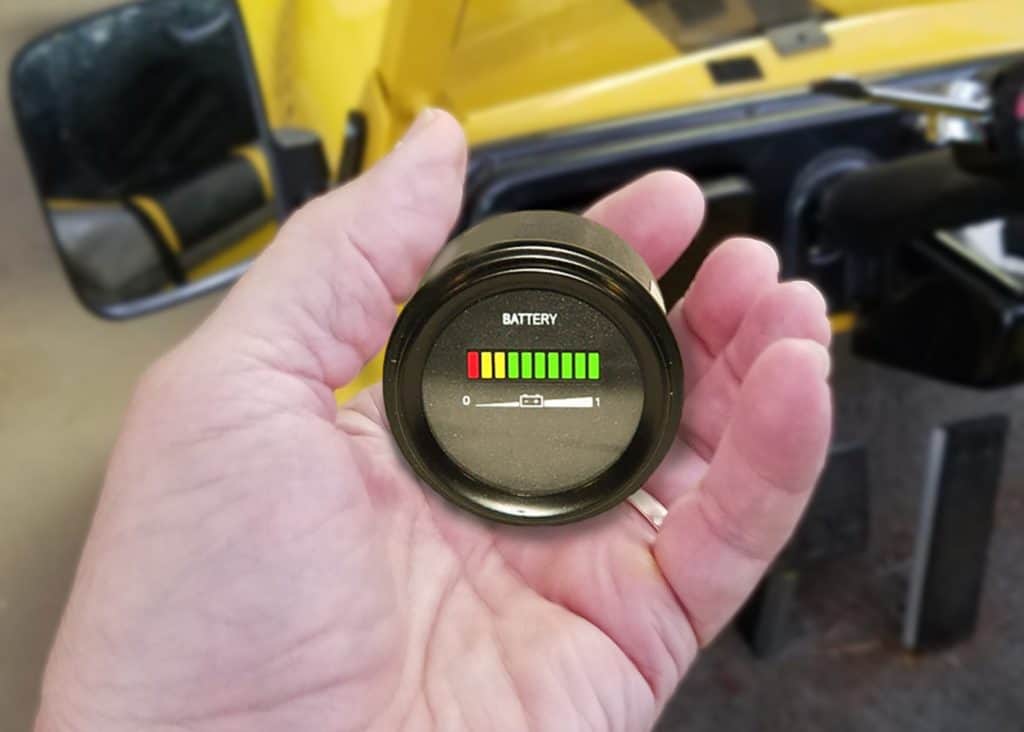To make a golf cart street legal, you need to follow crucial steps. Start by adding key features like headlights, brake lights, turn signals, mirrors, a windshield, and seatbelts. These items improve safety and visibility on the road.
Next, follow local regulations about speed limits and get a valid Vehicle Identification Number (VIN). Get a golf cart insurance policy to protect against road issues. Do regular maintenance checks to keep your cart running well.
By doing these things, you can follow local laws and safety rules. Learning more about these steps will help you keep your cart legal and up-to-date.
Key Takeaways
- Modify your golf cart by adding necessary road items. These include headlights, tail lights, brake lights, turn signals, mirrors, seat belts, and a windshield.
- Get a Vehicle Identification Number (VIN). This is needed for basic liability and to get the right insurance coverage.
- Make sure you follow all rules. These include local and state rules about how fast you can go, what kind of equipment you need, and where you can use your cart.
- Always check your golf cart to make sure it’s safe and working well. This includes regular inspections and taking care of any problems right away.
- Keep all important papers up to date. This includes things like your registration, insurance, and making sure your VIN is still good.
Understanding Street-Legal Requirements
Understanding how to make your golf cart street legal in Texas (for example) involves knowing the state’s rules. There are several things you need to do.
First, your golf cart must have certain equipment. This includes headlights, tail lights, and brake lights. You also need turn signals, mirrors, and a windshield. These are all important for safe driving. If you don’t have them, you could put yourself and others in danger.
Second, there’s a rule about speed. Golf carts can only go on roads where the speed limit is 35 mph or less. This is because golf carts are not made for fast driving. If you go over this speed limit, it could cause a crash.
Lastly, you need a valid driver’s license to drive a golf cart on the road. This proves that you know how to drive safely. It also shows that you know the rules of the road.
Where Are Golf Carts Allowed To Drive On Public Streets?
This is a listing of current states LSV restrictions:
| State | Roads Permitted? | Top Speed Permitted for LSV in MPH? |
|---|---|---|
| Alabama | Local option, municipal streets in class 2 municipalities during daylight hours | 25 |
| Alaska | The local ordinance may allow use on roads with a posted speed limit of 45 mph or less; otherwise roads with a posted limit of 35 mph or less. | 25 |
| Arizona | Roads with a posted speed limit of 35 mph or less | 25 |
| Arkansas | Roads on which a low-speed vehicle would not impede the normal and reasonable movement of traffic | 25 |
| California | Roads with a posted speed limit of 35 mph or less | 25 |
| Colorado | Roads with a posted speed limit of 35 mph or less; Colorado DOT may permit LSVs on some roadways with a speed limit equal to 40 mph | 25 |
| Connecticut | No state law | No state law |
| Delaware | Roads, other than dual highways in unincorporated areas, where the posted speed limit is 35 mph or less | 25 |
| District of Columbia | Roads on which a low-speed vehicle would not impede the normal and reasonable movement of traffic | 25 |
| Florida | Roads with a posted speed limit of 35 mph or less | 25 |
| Georgia | Roads with a posted speed limit of 35 mph or less | 25 |
| Hawaii | Roads with a posted speed limit of 35 mph or less | 25 |
| Idaho | Roads with a posted speed limit of 35 mph or less | 25 |
| Illinois | Roads with a posted speed limit of 30 mph or less; local ordinance may allow use on roads with a posted speed limit of thirty-five mph or less | 25 |
| Indiana | Roads with a posted speed limit of 35 mph or less | 35 |
| Iowa | Roads with a posted speed limit of 35 mph or less | 25 |
| Kansas | Roads with a posted speed limit of 30 mph or less | 25 |
| Louisiana | Roads with a posted speed limit of 35 mph or less | 25 |
| Maine | Roads with a posted speed limit of 35 mph or less | 35 |
| Maryland | Roads with a posted speed limit of 30 mph or less | 25 |
| Massachusetts | Roads with a posted speed limit of 30 mph or less | 25 |
| Michigan | Roads with a posted speed limit of 35 mph or less | 25 |
| Minnesota | Roads with a posted speed limit of 35 mph or less | 25 |
| Mississippi | No state Law | No state law |
| Missouri | Roads with a posted speed limit of 35 mph or less | 25 |
| Montana | No state law | No state law |
| Nebraska | Roads with a posted speed limit of 35 mph or less | 25 |
| Nevada | Roads with a posted speed limit of 35 mph or less | 25 |
| New Hampshire | Roads with a posted speed limit of 35 mph or less | 25 |
| New Jersey | Roads with a posted speed limit of 25 mph or less; the commissioner may permit use on specified roads where the posted speed limit is greater than 25 mph but not greater than 35 mph | 25 |
| New Mexico | Roads with a posted speed limit of 35 mph or less | 25 |
| New York | Roads with a posted speed limit of 35 mph or less | 25 |
| North Carolina | Roads with a posted speed limit of 35 mph or less | 25 |
| North Dakota | Roads with a posted speed limit of 35 mph or less | 25 |
| Ohio | Roads with a posted speed limit of 35 mph or less | 25 |
| Oklahoma | Roads with a posted speed limit of 35 mph or less | 25 |
| Oregon | Roads with a posted speed limit of 35 mph or less | 25 |
| Pennsylvania | Roads with a posted speed limit of 25 mph or less; the secretary may permit use on specified roads where the posted speed limit is greater than 25 mph but not greater than 35 mph | 25 |
| Rhode Island | Roads on Prudence Island with a posted speed limit of 25 mph or less during the hours of 6:00 am through 6:00 pm | 25 |
| South Carolina | Roads with a posted speed limit of 35 mph or less | 25 |
| South Dakota | Roads with a posted speed limit of 35 mph or less | 25 |
| Tennessee | Roads with a posted speed limit of 35 mph or less | 25 |
| Texas | Roads with a posted speed limit of 45 mph or less | 35 |
| Utah | Roads with a posted speed limit of 35 mph or less | 25 |
| Vermont | Roads with a posted speed limit of 35 mph or less | 25 |
| Virginia | Roads with a posted speed limit of 35 mph or less | 25 |
| Washington | Roads with a posted speed limit of 35 mph or less | 25 |
| West Virginia | Roads within the corporate limits of a municipality where the speed limit is 25 mph or less | 25 |
| Wisconsin | Local option may allow use on roads with a posted speed limit of 35 mph or less | 25 |
| Wyoming | Non-interstate highways on which the vehicle is capable of achieving the maximum speed limit | Not Specified |
Essential Golf Cart Modifications
After learning the rules for a street-legal golf cart in Texas, let’s focus on the specific changes needed. It’s crucial that your golf cart meets these street-legal standards.
Here are the vital changes to make your golf cart ready for the road:
- Set up headlights, taillights, brake lights, and turn signals. These are crucial for being seen, especially during night drives and when signalling turns.
- Put mirrors on your cart. Mirrors help you see the road and other vehicles, increasing safety.
- Attach a windshield. This guards passengers from wind and flying debris while driving.
- Fit seat belts. These are important safety features needed for street-legal carts.
- Improve your brake system. Strong brakes enhance stopping power and control, ensuring safety on the road.
Each change is vital not just to follow the law, but also for the safety of the driver and passengers. It’s important to remember getting a Vehicle Identification Number (VIN) is part of these rules. These changes are the basic liability requirements to make your cart a slow-moving vehicle emblem on the streets.
- Light Kit includes: (2) Adjustable Black Bezel LED headlights with LED amber running lights and turning signals
- (2) Adjustable Black Bezel LED taillights, (1) Brake Switch, TImer, and Brackets
- (1) Turn Signal Switch with Flashing Hazards, (1) Turn Signal Wire Column Cover
Securing Proper Golf Cart Insurance
Once you’ve made your golf cart street-legal, it’s crucial to get the right Golf Cart Insurance. This insurance helps you avoid potential problems on the road. It covers different things like damage, theft, and injuries from accidents. Remember, the cost of your insurance can change. It depends on things like your driving history and how much coverage you choose.
Many insurance companies have special policies just for golf carts. These detailed policies usually give more coverage. They’re a smart choice if you plan to drive your golf cart on public roads a lot. So, it’s key to look at different quotes from different insurance providers. This helps you find the best coverage that fits your needs and your budget.
Inspection and Maintenance Routine
To keep your golf cart running smoothly and safely, follow a regular check-up and upkeep routine. This not only makes the cart last longer but also ensures safety for the driver.
Part of this routine includes:
Complying With Local Regulations

Meeting local laws is crucial when maintaining your golf cart. This ensures not just its legality, but also the safety of you and others. For a street-legal golf cart in Texas, you need to follow certain rules. State law requires specific equipment like headlights, brake lights, seatbelts, and a horn.
Also, there are speed limits to be aware of. Knowing these laws is vital for different areas. Local authorities may have more regulations, so it’s wise to check with them. If you live in a community run by a Homeowners Association (HOA), they may also have rules for golf cart use.
Here is an example of a South Carolina DMV registration:
If you have a valid driver’s license, you may drive the golf cart during the day within four miles of your home or business and on secondary highways.
South Carolina DMV
To receive a golf cart permit, do all of the following:
Complete the Golf Cart Permit Registration (SCDMV Form GC-2) This is a PDF file
Provide proof of insurance for the golf cart
Provide your valid driver’s license number
Pay $5
You must replace your golf cart permit every five years or if you change your address.
Every municipality will be different, so be sure and check local DMV requirements. An online reference for different state laws may be downloaded from the International Light Transportation Vehicle Association Here
Safe Road Operation Guidelines
To drive your street-legal golf cart safely on public roads, you must obey all traffic laws and signs. Understanding these rules is key to using a golf cart on the street legally. By being alert and following rules, you can ensure the safety of everyone on the road. This includes the golf cart driver, passengers, pedestrians, and other drivers.
To practice safe driving, consider these points:
- Equip your golf cart with safety gear specified by the state. This includes rear-view mirrors, turn signals, and reflective devices.
- Stick to the speed limit set by local and state laws. Going too fast can be dangerous and may break the law.
- Always give way to pedestrians and incoming traffic. This is a basic rule of the road and an important safety step.
- Keep a safe distance from other vehicles on the road. This can help avoid accidents.
- Use lanes or road shoulders meant for you when possible. This is a good way to stay safe and follow equipment and operation rules.
Ongoing Compliance and Updates

Keeping your golf cart street legal means consistent adherence to safety rules and frequent updates. It’s crucial to routinely review and upgrade your cart’s safety features. This not just assures its safety but also its compliance with local street legal golf cart regulations.
Stay aware of any modifications in local or state guidelines. This forward-thinking approach will aid in preserving the street legality of your golf cart and dodge any legal issues. Keeping your documents, like registration and insurance, up-to-date is another vital part of staying compliant.
Regular upkeep is key in keeping your golf cart street legal. This includes making sure all required safety elements, such as lights, mirrors, and seat belts, are in good working order.
The chart below shows the ongoing needs:
| Need | Explanation | How Often |
|---|---|---|
| Safety Equipment Update | Review and upgrade safety features as needed | Regularly |
| Paperwork | Renew registration and insurance | As needed |
| Upkeep | Regular check to ensure all safety features are working | Regularly |
Frequently Asked Questions
How Do I Make My Club Car Street Legal?
To make your Club Car fit for the road, you must follow some legal steps. Start by adding aftermarket parts such as headlights and mirrors. These parts are necessary for safety and visibility. Next, you’ll need to obtain the correct licensing. This involves applying for a permit or license in your local area.
Don’t forget about insurance policies. It’s crucial to get the right insurance to protect you and your vehicle. Lastly, ensure you’re in line with local ordinances. Different areas have different rules for street-legal golf carts. Always remember, regular maintenance and safety measures matter a lot. Following these steps can help your Club Car meet street legal requirements.
Do I need to register my golf cart as a street legal vehicle?
Yes, in most jurisdictions, you will need to register your golf cart with the Department of Motor Vehicles (DMV) or similar body and get a license plate. You’ll also need to have insurance for your golf cart.
Will making my golf cart street legal affect its performance?
Making your golf cart street legal typically doesn’t affect its performance, but it does limit the maximum speed to ensure safety. However, adding additional accessories to meet street legal requirements may slightly impact the cart’s power due to the extra weight.
Are there specific laws pertaining to driving a street-legal golf cart in my area?
Laws can vary significantly by state, county, and city. It’s essential to check with local law enforcement or your local DMV to get the most accurate information regarding the legality of driving a golf cart on public roads in your specific area.
Conclusion
To make a golf cart legal for the street, understanding the requirements is key. You’ll need to modify your cart, get the right insurance, and follow your local regulations.
Regular checks and upkeep of your golf cart are important to ensure safety and legality. Knowing how to drive safely on the road is a must.
By keeping up with the latest rules, you can successfully make a golf cart street legal.






